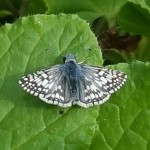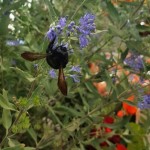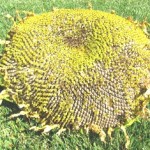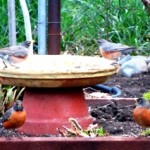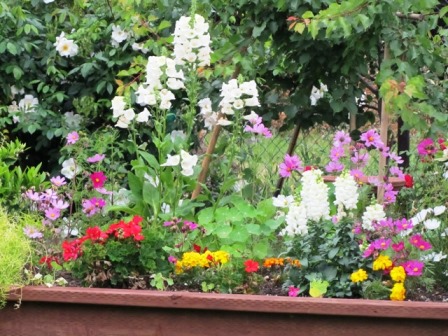Plant for the Pollinators
I seldom need an occasion to put in another bed of flowers, but this is National Pollinator Week. I think a new bed is in order to attract local bees, birds, bats, and butterflies–all considered pollinators. Having these small creatures around benefits landscapes, gardens, and orchards.
The U.S. Fish and Wildlife Service has noted that over 75 percent of our plants are pollinated by birds, animals, and insects. We can help ensure these creatures will be around for a long time if we restore their habitats and ensure they have food and water.
There are many lovely plants you can grow that don’t require a lot of care.
- lavender
- bee balm
- echinacea
- sage
- cilantro
- thyme
- sunflowers
- sweet alyssum
- anemone
- borage
- geraniums
- scented pelargoniums
- mint
A tapestry of colorful herbs and flowers beautifies your landscape and pollinators love the diversity. If you don’t have a lot of space, grow some of these plants in planter boxes, clay pots, or other types of containers.
Put in a water feature, too, such as a table-top or larger fountain that recycles water. Even a pottery saucer filled each day can attract pollinators.
It won’t take long for the bees and hummingbirds to find the water. Their frequent visits are fun to watch, and they’ll likely be sipping throughout the day.
_________________________________________________________________________
If you enjoy reading about farmette topics, check out my Henny Penny Farmette series of cozy mysteries from Kensington Publishing. My newest novel includes delicious recipes, tips on keeping bees and chickens, and much more. Click on this URL for more information, http://tinyurl.com/ya5vhhpm
.
How to Attract Local Pollinators
Today, I spotted a gorgeous bee, big and black with reddish-brown wings, dipping its proboscis into the lavender wisteria and other blooms in my garden. I was stung by a bee yesterday, but that doesn’t stop me from smiling with delight observing this little pollinator at work in my garden.
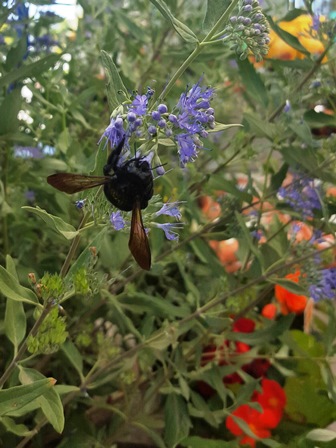
This longhorn bee, twice the size of a honeybee, dips its proboscis (meaning, tongue, nozzle, or snoot) into a bloom.
I admit I’m a fan of pollinators and enjoy watching them work amid the sunflowers, zinnias, cosmos, wisteria, and other blooms in the bee and butterfly garden I planted earlier this year.
The flowers attract hummingbirds, butterflies, bumblebees, and other types of bees, including my own Italian honeybees, the stock of bees most favored in this country (Apis mellifera ligustica). See, http://beesource.com/resources/usda/the-different-types-of-honey-bees/
Honeybees pollinate 90 percent of North America’s commercially produced crops, including almonds. That’s why many Northern California almond growers rent honeybees for use in their orchards during springtime bloom.
The National Academy of Sciences has noted that pollinators are needed to reproduce 75 percent of the Earth’s flowering plants. But there’s been a drop in natural pollinators, in part due to habitat loss and pesticide use.
Populations of the yellow, black, and brown Western bumblebee, once common from southern British Columbia to central California, have now all but disappeared. To attract bumblebees, plant giant hyssop, milk weed, and nettle-leaf horse mint. See, http://www.wildflower.org/collections/collection.php?collection=xerces_bumble
Here’s what else we gardeners and farmers can do to attract local pollinators.
1. Avoid using pesticides.
2. Plant bee, bird, and butterfly friendly native plants.
3. Choose plants that flower in varying diverse colors and shapes to attract a wide variety of pollinators.
* * *
If you enjoy reading about farmette topics (including gardening, beekeeping, and delicious recipes), check out my cozy mysteries A BEELINE TO MURDER and also THE MURDER OF A QUEEN BEE in the Henny Penny Farmette series (from Kensington Publishing).
These novels are available through online retailers such as Amazon, Barnes & Noble, Kobo Books, and Walmart as well as from traditional bookstores everywhere.
See, http://tinyurl.com/hxy3s8q
Now available in mass market paperback, this debut novel launched the Henny Penny Farmette series of mysteries and sold out its first press run.
See, http://tinyurl.com/h4kou4g
The second cozy mystery in the Henny Penny Farmette series, available Sept. 27, 2016
 Facebook
Facebook Goodreads
Goodreads LinkedIn
LinkedIn Meera Lester
Meera Lester Twitter
Twitter




